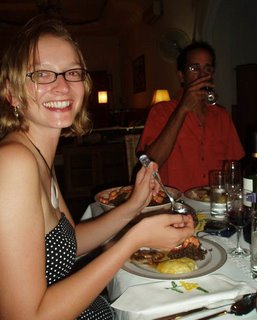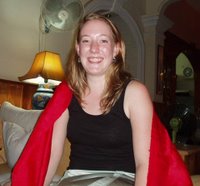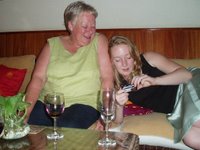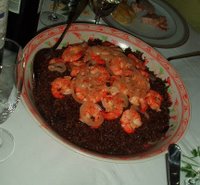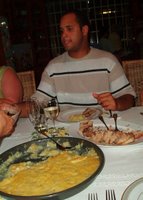For a full photo slideshow of our trip, visit my Flickr account.
As I have driven the five hour road to Siem Reap with work, I decided that to fly would be much more sensible. On Sunday morning, Mum and I left Phnom Penh, and half an hour later, arrived at Siem Reap’s new airport. Siem Reap is a wild place. At the moment it is going through an incredible, tourist-driven, development boom. In the last year approximately 10,000 new hotel rooms were built. Most of the town is being dug up in order to lay new infrastructure and pave roads.
On the advice of friends from Australia who had recently been ‘tourists’ in Siem Reap, we orgainsed to hire a guide with a car to take us around to the temples for three days. The special thing about our guide was that she was female. It is quite unusual to have a female guide; especially one in her early 20’s driving a car! Sarna was lovely, and immediately became very protective and caring towards Mum. She never left Mum’s side as we climbed over temple steps and tree roots for three days.
We took great delight every evening as we caught a tok tok back to our guest house after dinner, when the driver would inevitably ask ‘you need guide, Angkor Wat, good price..’ and we could say ‘no thank you, we have a guide, a lady guide, and she is driving a car’. They would laugh hysterically at this. Who ever heard of such a thing!
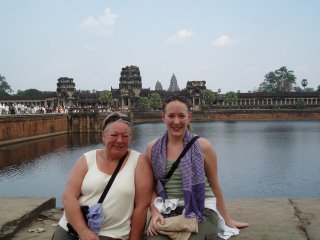 As Cambodia was heating up to its hottest period of the year, we decided to limit the number of temples we wanted to see during our visit to five: Angkor Wat, Banteay Srei, Bang Mealea, the Bayon and Ta Prohm.
As Cambodia was heating up to its hottest period of the year, we decided to limit the number of temples we wanted to see during our visit to five: Angkor Wat, Banteay Srei, Bang Mealea, the Bayon and Ta Prohm.We started our first afternoon with a visit to Angkor Wat. A truly incredible place. Being a very poor history student, I will not even attempt to delve into the complex past of this giant. For those interested to know more, you could start by visiting The Apsara Authority.
Unfortunately, Angkor Wat is now completely overrun with bus loads of tourists, and I found it hard to feel the magic of this place. We were glad to have the opportunity to visit, and appreciate the grandeur, however I think I need another visit during lunch time in the wet season (a moment when the least visitors are there) to fully appreciate Angkor Wat. As the sun set we walked to an outlying temple to watch the sky turn orange over Angkor, and then head back for dinner at my favourite restaurant in Siem Reap, Moloppor.
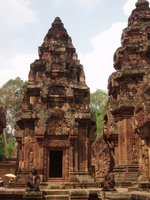
Or second day was surely the most memorable. On the advice of my good friend Martina, we organised to drive to Bang Mealea, a ruin in the jungle about two hours from Siem Reap. On the way, we stopped at beautiful Banteay Srei (‘Citadel of the Women’), a stunning small Hindu temple dedicated to Shiva. It has extremely delicate and detailed stone carvings including re-creations of scenes from the epic Ramayana. Seeing this temple bought back many memories of India for my mum, a feeling that will surely be reversed for me when I get the chance to visit there!
After our early morning visit to Banteay Srei, we took to the road again and headed towards Bang Mealea. Bang Mealea is in the middle of an ancient Angkorian road connection between Angkor Thom and Preah Khan in Preah Vihear Province, and has the same floor plan as Angkor Wat. The truly magical thing about Bang Mealea is that it has been left at the mercy of the jungle. Arriving at a small rural town, you must walk over an ancient bridge crossing a large moat, then through the jungle, passing oxen and local farmers, until the trees clear and you are faced with this enormous slumbering ruin. The beauty of this site is breathtaking. To see the temple in its true state of disrepair is more impressive than the large restored sites around Siem Reap, as you really get a sense of the age and scale of this ancient structure. Jungle vines twist and turn over gigantic stones, beautifully described by Martina as ‘Christmas presents wrapped in ribbon’. The surrounding trees provide a lovely dappled light, and shade from the afternoon sun.
A very simple and easy boardwalk has been built from the south entrance leading to the centre of the temple. From there it is up to your and your guide to carefully clamber through windows, into dark, damp corridors, and over huge piles of fallen stones. Mum and I shared a wonderful picnic lunch with Sarna, her cousin, and a local guard on the boardwalk overlooking the site, before separating to explore the area. Sarna and I took the more adventurous route, climbing up to the highest points of the temple, then through dark spooky corridors until we reached to outer path and made a lap around the temple. Mum took a walk through the centre of the temple, learning about the remaining carvings and history of the temple, and then out past the west entrance.
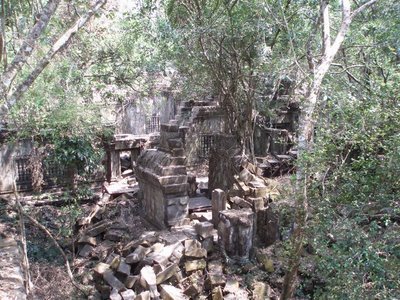
Unfortunately, one of the reasons for Bang Mealea’s current state of wild beauty and peacefulness makes reference to the country’s violent past. The site was extremely dangerous to access for many years, before 22,188 land mines could be cleared from the surrounds of the temple.
Bang Mealea is particularly special as few tourists venture this far from Siem Reap, so you can really have the place to yourself. Unfortunately, our guide informed us that Hun Sen recently made a visit to the site and declared that it has been left in this ruined state too long, and has ordered a restoration. Local workers are already hacking tree vines of the stones with axes, and pulling down trees. It will be a great shame when this is complete, as the temple will be nothing more than a sterile, smaller version of Angkor Wat. And as it has been left to the mercy of the jungle and monsoon rains for so long, most of the carvings are faded and worn.
In my opinion, this special testament to 9000 years of existence on this earth should be left to rest in peace.
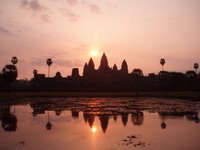 Our final day in Siem Reap, 28 February, was a chance to really appreciate the beauty of the Angkor Wat and Angkor Thom. We woke early to arrive at Angkor Wat in time to watch the sun rise. This is a spectacular site, and if you are prepared to step off the causeway, you can find a quite place to enjoy the experience out of view of thousands of tourists with tripods and lenses at the ready. The colours are beautiful, and as you will see from the photos, changing every minute. On this morning I took a moment to think of my RMIT ‘family’, and the loss of our dear friend one year earlier. Watching the sun rise over Angkor Wat was surely an appropriate place for some reflection of the past year.
Our final day in Siem Reap, 28 February, was a chance to really appreciate the beauty of the Angkor Wat and Angkor Thom. We woke early to arrive at Angkor Wat in time to watch the sun rise. This is a spectacular site, and if you are prepared to step off the causeway, you can find a quite place to enjoy the experience out of view of thousands of tourists with tripods and lenses at the ready. The colours are beautiful, and as you will see from the photos, changing every minute. On this morning I took a moment to think of my RMIT ‘family’, and the loss of our dear friend one year earlier. Watching the sun rise over Angkor Wat was surely an appropriate place for some reflection of the past year.After a quick breakfast trip back to town, we then spent the late morning visiting Angkor Thom. First, the Bayon, with its enormous towers decorated with the smiling faces of Avalokiteshvara, and 1.2km of remarkable bas-reliefs depicting scenes from 12th century Cambodian life. At the top of the Bayon, Mum had her future read by a fortune teller, who was impressed with her lucky palm…. I will keep my sceptical comments to myself.
After Bayon we visited the very beautiful Terrace of Elephants, a 350m-long terrace decorated with giant elephant carvings, that was used as a viewing stand during public-ceremonies and the King’s grand audience hall. Having been bought up by my mother who loves these creatures, we were both very touched to see such a beautiful depiction of these gorgeous giants.
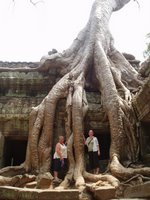
After this it was time to pull on the black body suits and channel Lara Croft for a visit to Ta Prohm, now a famous pop-culture reference due to the film ‘Tomb Raider’. A Buddhist temple dedicated to the mother of Jayavarman VII, this 8,000 year old site is especially beautiful due to the enormous jungle trees that have taken control of many structures, winding their huge trunks and roots around the temple to great effect.
With our temple visits complete, we made a final stop at the Golden Banana (our charming guest house) and a tour of the workshops and store at Artisans d’Angkor, before heading back to the airport for our late night flight to Hanoi.
Siem Reap is wild, beautiful, demanding and continually changing. I am sure you will be seeing more of the temples and surrounding ruins in future posts!
